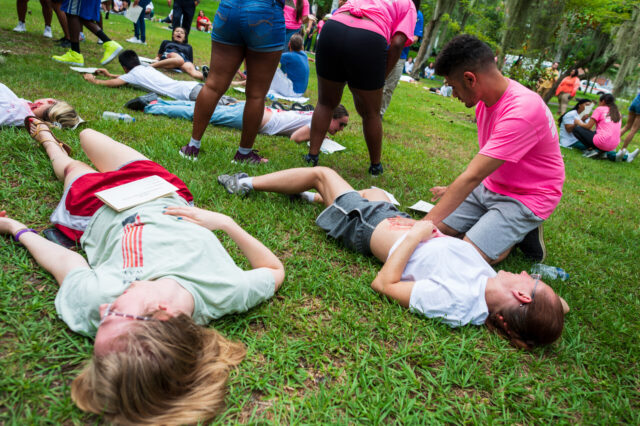Mass casualty drill at University of Florida teaches life lessons to summer students

Fake blood, authentic emergency responders and loud screams crowded the humid air Thursday morning on the University of Florida campus as nearly 80 students got real-world lessons in how to assess and treat catastrophic injuries during a mass casualty drill.
This is the third year that students in the University of Florida’s Summer Health Professions Education Program, or SHPEP, have participated in the exercise. This year, they gathered with faculty and staff at UF Health, along with UF emergency medicine residents, UF College of Nursing students and area first responders, to learn and practice lifesaving skills.
SHPEP is a free six-week program that provides freshmen and sophomores from colleges around the nation who are interested in the health professions a chance to learn more about the available opportunities. All six of UF’s health colleges participate.
On Thursday, the classroom was the north lawn outside of the UF College of Public Health and Health Professions.
Under the guidance of Jason Jones, M.D., and Charles Hwang, M.D., both emergency physicians with the UF College of Medicine’s department of emergency medicine, and Sven Norman, Pharm.D., a clinical associate professor in the UF College of Pharmacy, all the SHPEP students received basic first aid training before heading onto the field.
This year’s scenario echoed that of last summer: a bomb in a disgruntled student’s backpack had exploded during a battle of the bands event. Victims, adorned with realistic theatrical blood to help create the urgent atmosphere, were sprawled across the grassy area, some moaning, others screaming for help.
As soon as the SHPEP students got the go-ahead, they rushed to help the injured, who were played by UF emergency medicine residents and students, and volunteers from Rasmussen College in Ocala.
Separated into three teams, the SHPEP students assessed the injuries guided by papers the victim had that described their wounds. The rescuers had to make split-second decisions on prioritizing the injuries. They labeled each injury with a tag — black for deceased, red for those needing urgent care, yellow for injuries not requiring immediate attention and green for minor injuries.
Marcus Nguy, a SHPEP student, had just assigned a bruised pregnant woman a green tag after referring to his information sheet. “But if it were up to me, I would bring her in,” he said.
The students learned the basics of emergency care, including holding pressure on wounds and applying tourniquets, key elements of the U.S. Department of Homeland Security’s Stop the Bleed campaign. Launched in 2015, the nationwide awareness campaign encourages bystanders to become trained and empowered to help in an emergency before professional help arrives.
“Our primary goal is to teach students what they can do as a bystander to save lives,” said Hwang, who also serves as medical director for the Levy County Department of Public Safety.
“We have huge events at UF,” he said, most noteworthy being the Gator football games each fall. “Given the current events nationwide and worldwide, we are routinely faced with situations with many potential victims and limited resources. Having people trained in those situations is extremely important — especially on a large public campus.”
Although SHPEP has been implemented at 12 universities in the U.S. since 2017, UF was the first to incorporate a mass casualty drill in its program. Jones, who has been the co-director of the SHPEP mass casualty drill for all three years, said the drill emphasized the realities that emergency responders are increasingly facing.
“In a mass casualty incident, the number of victims exceeds the number of professional rescuers,” said Jones, who is also the medical director for Alachua County Fire Rescue. “The SHPEP students showed that when volunteers know how to help victims, we can dramatically increase the number of people we can save.”
Hwang said it’s vital for everyone to know how to react when a disaster occurs, especially due to the number of mass-casualty incidents in the U.S. and around the world. The students are taught that no matter what specialty they go into, there is a chance they may be called upon to provide medical care in an actual emergency.
The lessons learned on a steamy morning on a Florida campus could one day mean the difference between life and death, the leaders stressed.
“No one plans to be a victim or witness a tragedy,” Jones said, “but anyone can be a hero.”